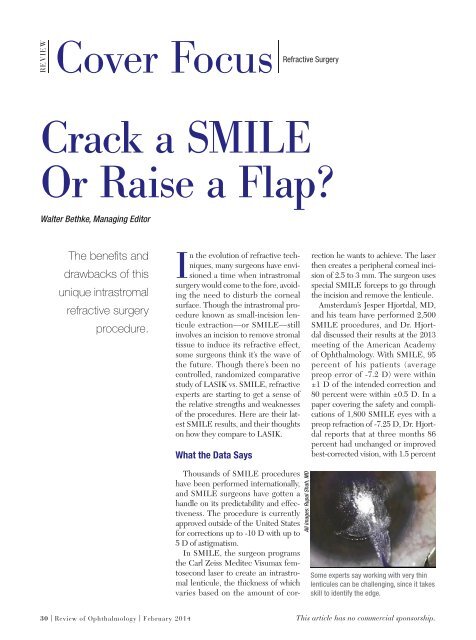dhjBa
dhjBa
dhjBa
You also want an ePaper? Increase the reach of your titles
YUMPU automatically turns print PDFs into web optimized ePapers that Google loves.
REVIEW<br />
Cover Focus<br />
Refractive Surgery<br />
Crack a SMILE<br />
Or Raise a Flap?<br />
Walter Bethke, Managing Editor<br />
The benefi ts and<br />
drawbacks of this<br />
unique intrastromal<br />
refractive surgery<br />
procedure.<br />
In the evolution of refractive techniques,<br />
many surgeons have envisioned<br />
a time when intrastromal<br />
surgery would come to the fore, avoiding<br />
the need to disturb the corneal<br />
surface. Though the intrastromal procedure<br />
known as small-incision lenticule<br />
extraction—or SMILE—still<br />
involves an incision to remove stromal<br />
tissue to induce its refractive effect,<br />
some surgeons think it’s the wave of<br />
the future. Though there’s been no<br />
controlled, randomized comparative<br />
study of LASIK vs. SMILE, refractive<br />
experts are starting to get a sense of<br />
the relative strengths and weaknesses<br />
of the procedures. Here are their latest<br />
SMILE results, and their thoughts<br />
on how they compare to LASIK.<br />
What the Data Says<br />
Thousands of SMILE procedures<br />
have been performed internationally,<br />
and SMILE surgeons have gotten a<br />
handle on its predictability and effectiveness.<br />
The procedure is currently<br />
approved outside of the United States<br />
for corrections up to -10 D with up to<br />
5 D of astigmatism.<br />
In SMILE, the surgeon programs<br />
the Carl Zeiss Meditec Visumax femtosecond<br />
laser to create an intrastromal<br />
lenticule, the thickness of which<br />
varies based on the amount of correction<br />
he wants to achieve. The laser<br />
then creates a peripheral corneal incision<br />
of 2.5 to 3 mm. The surgeon uses<br />
special SMILE forceps to go through<br />
the incision and remove the lenticule.<br />
Amsterdam’s Jesper Hjortdal, MD,<br />
and his team have performed 2,500<br />
SMILE procedures, and Dr. Hjortdal<br />
discussed their results at the 2013<br />
meeting of the American Academy<br />
of Ophthalmology. With SMILE, 95<br />
percent of his patients (average<br />
preop error of -7.2 D) were within<br />
±1 D of the intended correction and<br />
80 percent were within ±0.5 D. In a<br />
paper covering the safety and complications<br />
of 1,800 SMILE eyes with a<br />
preop refraction of -7.25 D, Dr. Hjortdal<br />
reports that at three months 86<br />
percent had unchanged or improved<br />
best-corrected vision, with 1.5 percent<br />
All images: Rupal Shah, MD<br />
Some experts say working with very thin<br />
lenticules can be challenging, since it takes<br />
skill to identify the edge.<br />
30 | Review of Ophthalmology | February 2014<br />
This article has no commercial sponsorship.


